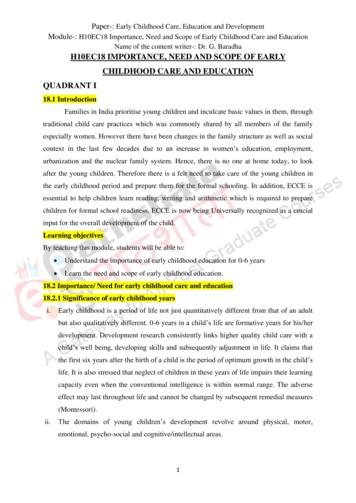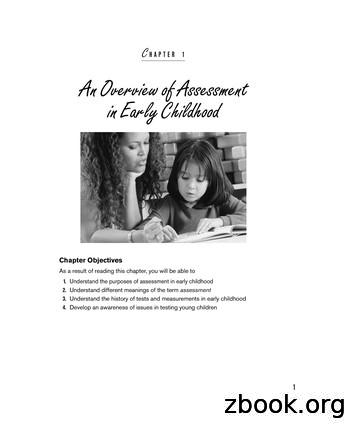Benefits Of Early Childhood Education And Care And The Conditions For .
eEuropean Expert Network onEconomics of Education (EENEE)Benefits of Early Childhood Education and Careand the conditions for obtaining themuropeEENEE Analytical Report No. 32Prepared for the European CommissionMichel Vandenbroeck, Karolien Lenaertsand Miroslav BeblavýJanuary 201832
Benefits of early childhood educationand care and the conditions forobtaining themMichel Vandenbroecka, Karolien Lenaertsb and Miroslav BeblavýbaDepartment of Social Work and Social Pedagogy, Faculty of Psychology and Educational Sciences, GhentUniversity, Belgium.bJobs & Skills Unit, Centre for European Policy Studies (CEPS), Brussels, Belgium.The authors are grateful to Martina Viarengo and Pawel Bukowski for their constructive comments andsuggestions on an earlier version of this report. All remaining errors should be attributed to the authors.
Europe Direct is a service to help you find answersto your questions about the European Union.Freephone number (*):00 800 6 7 8 9 10 11(*)The information given is free, as are most calls (though some operators, phoneboxes or hotels may charge you).More information on the European Union is available on the Internet (http://europa.eu).Luxembourg: Publications Office of the European Union, 2018ISBN: 978-92-79-70090-3doi: 10.2766/20810 European Union, 2018All rights reserved.This document has been prepared for the European Commission. However, it reflects the views onlyof the authors, and the Commission cannot be held responsible for any use which may be made ofthe information contained therein.
ContentsContents. 2List of Figures . 4List of Tables. 4Executive Summary . 51.Introduction . 112.Conceptualisation of early childhood education and care and its forms . 133.2.1What is early childhood education and care? . 132.2Typology of early childhood education and care provision . 142.3Participation in early childhood education and care in Europe . 16Potential benefits of early childhood education and care . 223.1Background . 223.2Education and development . 333.2.1Individual benefits . 333.2.2Societal benefits. 343.3Labour market . 353.3.1Individual benefits . 353.3.2Societal benefits. 373.43.4.1Individual benefits . 383.4.2Societal benefits. 393.5Health and well-being . 403.5.1Individual benefits . 403.5.2Societal benefits. 413.6Crime and justice . 413.6.1Individual benefits . 413.6.2Societal benefits. 423.7Other effects . 433.7.1Support . 433.7.2Spillover benefits . 433.84.Poverty, inequality, social cohesion and inclusion . 38Concluding remarks . 44Conditions for realising the potential benefits of early childhood education and care . 464.1Role of the policy framework . 464.1.1Interaction between the EU, national and sub-national levels . 484.1.2National policy priorities in the field of early childhood education and care. 484.2Role of the system and the curriculum . 534.2.1Curriculum. 534.2.2System . 544.3Role of teachers and staff . 583
5.4.4Role of the parents and family background . 604.5Concluding remarks . 62Conclusions and policy recommendations . 63Bibliography . 67List of FiguresFigure 1. Distribution of pupils in early childhood educational development programmes across publicand private institutions . 16Figure 2. Distribution of pupils in pre-primary education across public and private institutions . 16Figure 3. Percentage of children younger than 3 cared for in formal structures in 2010–11 . 17Figure 4. Percentage of children between the age of 3 and the mandatory school age cared for informal structures in 2010–11 . 18Figure 5. Formal childcare by age category in relation to the Barcelona targets . 18Figure 6. Returns to education for all children . 25Figure 7. Returns to education for children with different socio-economic backgrounds . 26Figure 8. Costs and benefits associated with three major programmes for early childhood educationand care in the US . 29Figure 9. Effects of social class and participation in early childhood education and care on literacy atage 7 . 33Figure 10. Impact of early childhood education and care on individuals and society. 45Figure 11. Total public expenditure on early childhood education and care in 2013 (% of GDP) . 50Figure 12. Average child-to-staff ratios in pre-primary education services, 2014 (public and privateISCED 02(0) services, based on full-time equivalents) . 56Figure 13. Average child-to-staff ratios in early childhood development services, 2014 (public andprivate ISCED 01(0) services, based on full-time equivalents) . 57List of TablesTable 1. Characteristics of provision of early childhood education and care . 54Table 2. Evidence on the main benefits of ECEC, by group and type of impact . 654
Executive Summary (English)In the European Union, early childhood education and care (ECEC) has been a growing priority in manyMember States. Whereas education has long been high on the policy agenda, early childhood educationand care has only started to receive attention more recently. This interest in the early years is inspiredby a rapidly expanding body of scientific research in different disciplines that points to substantialeconomic, social, educational and developmental benefits of participating in high-quality earlychildhood education and care. These benefits are not limited to the children involved, but extend tosociety at large. At the level of the individual, participation in high-quality early childhood educationand care is associated with higher earnings, greater educational attainment, improved social integrationand better health, among other advantages. Moreover, for parents, it is found to encourage labour marketparticipation, especially of mothers, in addition to educational and other impacts. At the societal level,there are ample potential benefits as well, ranging from reduced spending on welfare and lower crimerates to higher tax revenues and improved social cohesion. In other words, the benefits are bothwidespread and long-lasting.Besides the abundant research, the increased attention on early childhood education and care can alsobe explained by demographic and economic changes that the EU Member States have experienced overthe last years. Across the EU, women’s labour market participation has grown, thus increasing thedemand for childcare. Moreover, as working lives are being extended, the role of grandparents inchildcare is diminishing. Societies have become more diverse, in cultural and linguistic terms. Evolvingcareer aspirations, declining fertility rates and the rising ages of those giving birth have all tremendouslychanged how childcare is organised. These demographic dynamics lead to an increased demand forformal childcare outside the home. In addition, informal forms of childcare are in decline in manyMember States. Another factor to take into account is the past financial–economic crisis, which ledgovernments to scale down spending on education in some Member States. Spending on early childhoodeducation and care is generally lower than that on other education levels, despite the evidence on itsimportance for future learning and growth and the finding that returns on investment are higher thanthose for other education levels.For these reasons, investing in early childhood education and care has been advocated by academics andpolicy-makers. At the EU level, there are explicit targets for it: one of the EU2020 benchmarks stipulatesthat at least 95% of children between the age of 4 and the age for starting compulsory primary educationshould participate in such education and care by 2020. Whereas the EU is close to meeting this targetaccording to the 2016 “Education and Training Monitor”1, the target set at the 2002 Barcelona EuropeanCouncil of having at least 33% of children aged under 3 participate in childcare by 2010 has still notbeen attained. In fact, the share remained below 20% in ten EU Member States in 2014. Furthermore,engaging children from disadvantaged groups remains a major challenge, which is particularly relevantin light of the recent inflow of refugees. Early childhood education and care can serve as an instrumentto overcome disadvantage by opening up a child’s world to other influences. Further efforts to supportearly childhood education and care will, therefore, continue to be necessary in the following years.Against this background, this report sets out to examine possible incentives to invest in early childhoodeducation and care in the European context. More specifically, it presents evidence on the potentialbenefits of early childhood education and care and the conditions under which these benefits can berealised. The report focuses on economic and other benefits, at the individual and societal level. To thisend, the report starts with a conceptualisation of early childhood education and care and a descriptionof the current state of play, while also outlining the different types of provision found in Europe. Thereport then discusses the potential benefits from early childhood education and care for multiple aspects,such as education and labour market outcomes, educational equalities of opportunity, social cohesion,government expenditure and revenues. Subsequently, the report looks at different types of determinantsthat may influence whether these potential benefits can materialise. Recent research emphasises that, in1See European Commission (2016b).5
this regard, both the accessibility and the quality of early childhood education and care provision matter.In others words, children need to be able to participate in high-quality ECEC in order to reap the benefitsassociated with it, and the same conclusion applies to the potential benefits that fall on other individualsand society. This report focuses on the roles of teachers and other staff, the system and curriculum, andthe policy framework governing ECEC in ensuring affordability and quality.From the scientific research presented in this report, it is clear that there are many incentives to investin early childhood education and care. However, both the accessibility and quality of ECEC need to beensured for all children, and disadvantaged children in particular. How early childhood education andcare are provided is as important as whether it is provided. Towards this end, governance, organisation,and staff are key. At the governmental level, both the generosity of the spending and the monitoring ofinputs and outcomes is important. With regard to spending, it is clear that ECEC is not a priority in mostEU Member States, and funding has been reduced during the crisis and in its aftermath. Monitoring is acommon practice in the EU. This involves monitoring the quality of the staff, service and curriculum,as well as child development, though there is much discussion on the latter. With regard to the systemand curriculum, universal access appears to be more effective than targeted access in attracting childrenfrom disadvantaged groups into ECEC, but this is also more expensive. Education and care need to becombined. In addition, ECEC provisions need to have sufficient and well-trained staff, so that factorsas wages, training and management also come into play. Reaping the benefits of ECEC thus implies thatpolicy-makers need to target several fronts at the same time.6
Executive Summary (French)Dans l'Union européenne, l'éducation et l'accueil des jeunes enfants (EAJE) constitue une prioritécroissante pour de nombreux États membres. Ce n'est que très récemment que l'éducation et l'accueildes jeunes enfants a commencé à recevoir une attention particulière, bien que l'éducation figure depuislongtemps parmi les priorités politiques. Cet intérêt pour la petite enfance découle de recherchesscientifiques en rapide développement dans différentes disciplines. Elles mettent en évidence lesavantages économiques, sociaux, éducatifs et de développement considérables de la participation desjeunes enfants à une éducation et un accueil de qualité. Ces avantages ne se limitent pas aux enfantsconcernés, mais s'étendent à l'ensemble de la société. Au niveau de l'individu, la participation des jeunesenfants à une éducation et un accueil de qualité est associée, entre autres avantages, à des revenus plusélevés, à un meilleur niveau d'éducation, à une meilleure intégration sociale et à une meilleure santé.Par ailleurs, il est constaté qu'elle encourage l'inclusion sur le marché du travail pour les parents, enparticulier les mères, en plus des impacts éducatifs et autres. Au niveau sociétal, on retrouve égalementde nombreux avantages potentiels. Ceux-ci vont de la réduction des dépenses d'aide sociale et des tauxde criminalité à la hausse des recettes fiscales et à l'amélioration de la cohésion sociale. En d'autrestermes, les avantages sont à la fois étendus et durables.Outre les nombreuses recherches, l'attention accrue portée à l'éducation et à l'accueil de qualité desjeunes enfants peut également s'expliquer par les changements démographiques et économiques que lesÉtats membres de l'UE ont connu ces dernières années. Dans toute l'UE, la participation des femmes aumarché du travail a augmenté, ce qui a accru la demande de services d'accueil des jeunes enfants. Deplus, à mesure que la vie professionnelle s'allonge, le rôle des grands-parents dans la garde de leurspetits-enfants diminue. Les sociétés se sont diversifiées, en termes culturels et linguistiques. L'évolutiondes aspirations professionnelles, la baisse des taux de fécondité et l'augmentation de l'âge des femmesenceintes ont profondément modifié l'organisation des services d'accueil des jeunes enfants. Cesdynamiques démographiques entraînent une demande accrue de services d'accueil formels à l'extérieurdu foyer. En outre, le recours à des formes informelles de services d'accueil des jeunes enfants est endéclin dans de nombreux États membres. Par ailleurs, il convient également de tenir compte de la crisefinancière et économique passée, qui a conduit les gouvernements de certains États membres à réduireles dépenses dédiées à l’éducation. Les dépenses consacrées à l'éducation et l'accueil des jeunes enfantssont généralement inférieures à celles affectées aux autres niveaux d'éducation, en dépit des donnéesprobantes sur leur importance pour l'apprentissage et la croissance futurs et du fait que le retour surinvestissement est supérieur à celui des autres niveaux d'éducation.C'est pourquoi les universitaires et les décideurs politiques préconisent d'investir dans l'éducation etl'accueil des jeunes enfants. Il existe au niveau de l'UE des objectifs explicites à cet égard : l'un desindicateurs de référence de la stratégie européenne « Europe 2020 »stipule qu'au moins 95 % des enfantsâgés entre 4 ans et l'âge minimum de scolarisation obligatoire, doivent participer à l’enseignementpréscolaire d'ici 2020. Alors que l'UE est sur le point d'atteindre cet objectif selon le « Suivi del'éducation et de la formation » de 2016, l'objectif fixé en 2002 par le Conseil européen de Barcelone,à savoir qu'au moins 33 % des enfants de moins de 3 ans bénéficient de services d'accueil des jeunesenfants d'ici 2010, n'a toujours pas été atteint. Dans les faits, cette part est restée inférieure à 20 % dansdix États membres de l'UE en 2014. Par ailleurs, la participation des enfants issus de groupes défavorisésreste un défi majeur, qui se révèle particulièrement important compte tenu du récent afflux de réfugiés.Les services d'éducation et d'accueil des jeunes enfants peuvent servir d'instrument pour surmonter lesdésavantages, en ouvrant le monde de l'enfant à d'autres influences. Des efforts supplémentaires serontdonc nécessaires dans les années à venir pour les soutenir.Dans ce contexte, le présent rapport se propose d'examiner les incitations possibles à investir dansl'éducation et l'accueil des jeunes enfants dans le contexte européen. Plus précisément, il présente despreuves sur les avantages potentiels de l'éducation et l'accueil des jeunes enfants et les conditionsnécessaires pour que ces retombées puissent être obtenues. Le rapport met l'accent sur les avantages,notamment économiques, au niveau individuel comme au niveau sociétal. A cette fin, le rapport7
commence par une conceptualisation de l'éducation et de l'accueil des jeunes enfants et une descriptionde la situation actuelle, tout en décrivant également les différents types de services disponibles enEurope. Le rapport examine ensuite les avantages potentiels de l'éducation et de l'accueil des jeunesenfants pour de multiples aspects, tels que les résultats en matière de scolarité et sur le marché du travail,l'égalité des chances en matière d'éducation, la cohésion sociale, les dépenses et les revenus publics. Lerapport étudie ensuite différents types de facteurs susceptibles d'influer sur la matérialisation de cesavantages potentiels. Des recherches récentes soulignent qu'à cet égard, l'accessibilité et la qualité desservices d'éducation et d'accueil des jeunes enfants sont des points importants. En d'autres termes, lesenfants doivent pouvoir prendre part à une EAJE de haute qualité afin d'en tirer pleinement profit. Lamême conclusion s'applique aux avantages potentiels qui incombent aux autres individus et à la société.Le présent rapport met l'accent sur le rôle des enseignants et autres catégories de personnels, sur lesystème et les programmes d'études ainsi que sur le cadre stratégique régissant l'EAJE afin d'assurer sonabordabilité et sa qualité.D'après les recherches scientifiques présentées dans ce rapport, il est clair qu'il existe de nombreusesincitations à investir dans l'éducation et l'accueil des jeunes enfants. Toutefois, l'accessibilité et la qualitéde l'EAJE doivent être assurées pour tous les enfants, et en particulier pour les enfants défavorisés. Lafaçon dont l'éducation et l'accueil des jeunes enfants sont pourvus est aussi importante que la questionde savoir s'ils le sont ou non. A cette fin, la gouvernance, l'organisation et le personnel sont essentiels.Au niveau gouvernemental, tant la générosité des dépenses que le suivi des moyens et des résultats sontimportants. En ce qui concerne les dépenses, il est clair que l'EAJE ne représente pas une priorité dansla plupart des États membres de l'UE et que le financement a été réduit pendant la crise et par la suite.Le suivi est une pratique courante dans l'UE. Il s'agit de surveiller la qualité du personnel, des serviceset des programmes d'études, ainsi que le développement de l'enfant, même si ce dernier point faitl'objet de longues discussions. En ce qui concerne le système et les programmes d'études, l'accèsuniversel semble plus efficace que l'accès ciblé pour attirer les enfants des groupes défavorisés versl'EAJE, mais il se révèle aussi plus coûteux. L'éducation et l'accueil doivent être combinés. De plus, lesservices d'EAJE doivent être dotés d'un personnel suffisant et bien formé, de sorte que certains facteurscomme les conditions salariales, la formation et la gestion entrent également en ligne de compte. Tirerprofit des avantages de l'EAJE implique donc que les décideurs politiques doivent agir sur plusieursfronts simultanément.8
Executive Summary (German)Viele Mitgliedstaaten der Europäischen Union legen inzwischen viel Wert auf frühkindliche Betreuung,Bildung und Erziehung. Während Bildung schon seit längerem weit oben auf der politischen Agendasteht, bekommt die frühkindliche Betreuung, Bildung und Erziehung (FBBE) jedoch erst seit kurzemmehr Aufmerksamkeit. Dieses Interesse für die frühen Jahre wird durch die schnell wachsende Zahlwissenschaftlicher Untersuchungen in diversen Fachrichtungen angeregt, die zeigen, dass n Nutzen verbunden ist. Diese Nutzen bleiben nicht auf die betreutenKinder beschränkt, sondern wirkt sich auf die Gesellschaft als Ganzes aus. Auf der individuellen Ebeneist die Teilhabe an einer hochwertigen FBBE unter anderem mit einem höheren Einkommen, höherenBildungsabschlüssen, einer besseren sozialen Integration und gesundheitlichen Vorteilen verbunden.Und sie wirkt sich nicht nur positiv auf den Bildungserfolg der Kinder aus, sondern erleichtert auch dieTeilnahme der Eltern, insbesondere der Mütter, am Arbeitsmarkt. Auch auf gesellschaftlicher Ebenegibt es zahlreiche Nutzen, z. B. sinkende Sozialausgaben, weniger Kriminalität, höhereSteuereinnahmen und ein bessere soziale Zusammenhalt. Anders ausgedrückt, sind die Vorteilevielfältig und dauerhaft.Das zunehmende Interesse für FBBE lässt sich aber nicht nur mit den umfangreichenForschungsergebnissen, sondern auch mit dem demografischen und wirtschaftlichen Wandel erklären,den die Mitgliedstaaten der EU in den letzten Jahren durchlebten. In der gesamten EU ist die Beteiligungvon Frauen am Arbeitsmarkt gestiegen; was sich auf die Nachfrage nach Betreuungsangeboten auswirkt.Gleichzeitig sinkt die Bedeutung der Großeltern bei der Kinderbetreuung, weil sich dieLebensarbeitszeit immer weiter verlängert. Die Gesellschaften sind kulturell und sprachlich vielfältigergeworden. Ehrgeizigere Karrierewünsche, sinkende Geburtenraten und das zunehmende Alter derGebärenden haben die Organisation der Kinderbetreuung grundlegend verändert. Aufgrund dieserdemografischen Trends steigt die Nachfrage nach einer formalen Kinderbetreuung außerhalb derFamilie. Außerdem nehmen informelle Formen der Kinderbetreuung in vielen Mitgliedstaaten ab. Einweiterer wichtiger Faktor ist die letzte Finanz- und Wirtschaftskrise, die die Regierungen einigerMitgliedstaaten dazu gezwungen hat, die Mittel für Bildung zu kürzen. Obwohl die Bedeutung derFBBE für den künftigen Bildungserfolg und das Wachstum klar erwiesen ist und die Forschung zeigt,dass Investitionen in diesem Bereich mehr Rendite bringen als in anderen Bildungsstufen, sind dieAusgaben für die FBBE insgesamt niedriger als die für andere Bildungsstufen.Aus diesen Gründen sprechen sich sowohl die Wissenschaft als auch die Politik für Investitionen in dieFBBE aus. Auf europäischer Ebene wurden bereits konkrete Zielvorgaben festgelegt: eine derBenchmarks der Strategie Europa 2020 sieht vor, dass mindestens 95 % der Kinder im Alter zwischenvier Jahren und dem gesetzlichen Einschulungsalter in den Genuss einer Vorschulbildung kommensollen. Nach Daten des „Monitor für die allgemeine und berufliche Bildung“ der EuropäischenKommission für 2016 hat die EU diese Quote zwar fast erreicht, aber das 2002 vom Europäischen Ratvon Barcelona beschlossene Ziel, bis 2010 für mindestens 33 % der Kinder unter drei Betreuungsplätzezu schaffen, wurde jedoch verfehlt. Im Jahr 2014 lag die Quote in zehn Mitgliedstaaten sogar noch unter20 %. Insbesondere die Bereitstellung von Betreuungsangeboten für Kinder aus benachteiligtenGruppen bleibt ein Problem, das sich durch den aktuellen Zuzug von Flüchtlingen noch verschärft.Frühkindliche Betreuung, Bildung und Erziehung öffnet eine neue Welt von Einflüssen für Kinder undkann so sozio-ökonomische Benachteiligungen ausgleichen. Daher sind in den kommenden Jahrenweitere Anstrengungen zur Förderung der FBBE erforderlich.Vor diesem Hintergrund untersucht dieser Bericht mögliche Anreize für Investitionen in die FBBE imeuropäischen Kontext. Konkret stellt der Bericht Daten über die potenziellen Nutzen der FBBE und überdie Bedingungen bereit, unter denen diese Nutzen erzielt werden können. Dabei konzentriert sich derBericht auf die wirtschaftlichen und sonstigen Nutzen auf individueller und gesellschaftlicher Ebene.Zu diesem Zweck beginnt der Bericht mit einer Konzeptualisierung von frühkindlicher Betreuung,Bildung und Erziehung sowie einer Beschreibung der aktuellen Situation und der unterschiedlichen9
Betreuungsformen in Europa. Danach erläutert der Bericht die potenziellen Nutzen der FBBE inunterschiedlichen Bereichen, z. B. Bildungserfolg und Erfolg auf dem Arbeitsmarkt, besserChancengleichheit in der Bildung, sozialer Zusammenhalt und öffentliche Ausgaben und Einnahmen.Anschließend untersucht der Bericht, von welchen Faktoren es abhängt, ob diese Nutzen tatsächlichrealisiert werden können. Aktuelle Forschungsdaten betonen, dass in dieser Hinsicht sowohl dieVerfügbarkeit als auch die Qualität von FBBE wichtig sind. Anders ausgedrückt, brauchen KinderZugang zu einer hochwertigen FBBE, um in den Genuss ihrer Vorteile zu kommen; dies gilt auch inBezug auf die Nutzen für andere Personengruppen und die Gesellschaft als Ganzes. Der Schwerpunktdieses Berichts liegt hier auf der Rolle von Lehrern, Pädagogen und sonstigen Mitarbeitern, auf demSystem und Lehrplan und auf den politischen Rahmenbedingungen, von denen Kosten und Qualität derFBBE abhängen.Die in diesem Bericht präsentierten wissenschaftlichen Untersuchungen zeigen, dass es viele guteGründe gibt, in FBBE zu investieren. Dabei muss jedoch gewährleistet sein, dass FBBE von hoherQualität und für alle Kinder zugänglich ist, insbesondere für benachteiligte Kinder. Wie FBBEbereitgestellt wird, ist genauso wichtig, wie dass sie bereitgestellt wird. Die wichtigsten Faktoren indi
Benefits of early childhood education and care and the conditions for obtaining them Michel Vandenbroecka, Karolien Lenaertsb and Miroslav Beblavýb a Department of Social Work and Social Pedagogy, Faculty of Psychology and Educational Sciences, Ghent University, Belgium. b Jobs & Skills Unit, Centre for European Policy Studies (CEPS), Brussels, Belgium.
Understand the importance of early childhood education for 0-6 years Learn the need and scope of early childhood education. 18.2 Importance/ Need for early childhood care and education 18.2.1 Significance of early childhood years i. Early childhood is a period of life not just quantitatively different from that of an adult
Early Childhood Education I L1 Early Childhood Education II L2 Early Childhood Education III L3C Early Childhood Education Advanced Studies AS The core course sequencing with the complementary courses provided in the following table serves as a guide to schools for their programs of study.
ECE 240 - Administration of Early Childhood Care and Education Programs (3) ECE 241 - Administration: Human Relations for Early Childhood Education (3) Colorado Mesa University B.A. Early Childhood Education - Early Childhood Special Education Advisor: Vail Shoultz-McCole vshoultz@coloradomesa.edu 970-255-2674
Early Childhood Care, Development and Education (ECCDE) is a term that is used interchangeably worldwide but refers to the same concept of early childhood education and cognitive development. The World Bank for instance refers to it as Early Childhood Care and Education, whereas UNESCO refers to it as Early Childhood Development Care.
T.E.A.C.H. Early Childhoodâ PENNSYLVANIA Certification Only Scholarship What is the Purpose of the T.E.A.C.H. Early Childhood Certification Only Scholarship? The purpose of the T.E.A.C.H. Early Childhood Certification Only Scholarship is to assist early childhood teachers in obtaining their PA Early Childhood Education (PreK-4) teaching certificate.
Center-Based and Family Child Care Early Childhood Education Reviewer The Early Childhood Education (ECE) Reviewer must meet one of the following sets of education and experience options: Education and Experience Option I 1. B.A., B.S., or advanced degree in early childhood education/child development or home
CHAPTER 1 An Overview of Assessment in Early Childhood Understanding Assessment in Infancy and Early Childhood Not too long ago, resources on early childhood assessment were limited to occa-sional articles in journals, chapters in textbooks on teaching in early childhood pro-grams, and a few small textbooks that were used as secondary texts in .
diploma in early childhood development & education If you have a natural love for children and a strong interest in early childhood education, then why not play an active role in shaping a child's growth with our Diploma in Early Childhood Development & Education [ECDE]?























